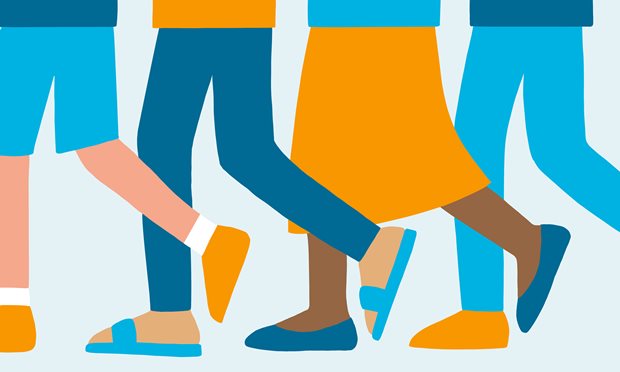

About this platform
These pages about walking difficulties in Parkinson's disease have been developed for people with Parkinson's, their loved ones, and parkinson healthcare providers. It is dedicated to the creative ways to improve gait: so-called 'compensation strategies'.
read moreAbout this platform
This website about walking difficulties in Parkinson's disease have been developed for people with Parkinson's, their loved ones, and Parkinson healthcare providers. It is dedicated to the creative ways to improve gait: so-called 'compensation strategies'.
On this platform you will find a video overview of the known strategies, including background information. In addition, you have the opportunity to contribute to this overview yourself by sending in videos of your own successful strategies.
This way, this website forms an interactive platform where people with Parkinson's disease and healthcare professionals can learn from each other. By doing so, we hope to make it easier for everyone to find helpful ways to improve walking.
Share your video
Are you using a compensation strategy that has not been included in our video overview? Please do share your idea. Your video might be on this page too!
to the formStep by step finding your strategy
Tips on determining the strategies that might be right for you. read moreStep by step finding your strategy
What strategy will work for you?
Individual compensatory strategies do not all have the same effect for every person with Parkinson's disease. What works for one person may have no, or even an adverse effect on walking in another. We also now know that the effect of a strategy can depend on the situation in which the strategy is necessary. For example, starting walking may require a different strategy than making a turn or crossing a narrow space. It is therefore important to try out different compensation strategies, in order to determine which strategies work best for you and your situation. But how do you approach this?
Finding the best strategy is a very personal process, as it is highly dependent on your personal preferences and needs. Unfortunately, we cannot (yet) predict who will benefit from a particular strategy and who may not. This also means that we cannot write an exact recipe for finding the best strategies for you. We can, however, offer a number of general guidelines that could support you in your search for the optimal strategies in your situation:
The steps
-
Determine which aspects of walking you would like to improve using a strategy. For example: are you looking for support of the walking rhythm, do you want to focus on making bigger strides, or are you looking for a strategy that will help you in overcoming freezing episodes? More information on the types of walking problems that can occur in Parkinson’s disease can be found at walking difficulties with parkinson.
-
Determine in which situations you would most likely need, or want to use the strategy. For example: if you go for a walk in the woods, if you have to make a narrow turn in the kitchen, or if you have to walk to the toilet at night?
-
Let’s get started! Select a number of strategies from the overview that appeal to you, preferably from different categories. Try the strategies with a partner/relative/friend in the situation where you would actually like to apply the strategy in the future. Some strategies will work well, others may not work at all: it's a matter of trying it out and seeing if it fits your personal needs.
-
You can also experiment with combining different strategies to optimize them for your situation. For example: combine counting while walking with raising the knees up higher. You can get creative with it, and adapt the strategies proposed on this website to your own preferences. Watch the example video 'Counting'.
-
It may be helpful to document which strategies you have already tried, in which situations you have tried them, and how they affected your walking ability. It will also make it easier for you to share your process with us. An example of such documentation can be found in the table below. If you like, you can print it out to write down your experiences during your search for suitable strategies, or use it as an inspiration for your own documentation system.
|
Strategy |
From category |
Situation/context |
Effect on my walking ability |
|
Counting 1-2-3-4 |
Internal cueing |
Taking the first step after getting up from a chair. |
Works well: able to start walking more easily. |
|
Walking to the rhythm of a metronome |
External cueing |
Hiking outdoors |
Does not work: my walking did not improve. |
|
… |
… |
… |
… |
Download this table as a Word document, so you can fill it with your own experiences.
Walking difficulties in Parkinson's disease
Information on the gait difficulties that can occur in Parkinson's disease. read moreWalking difficulties in Parkinson's disease
Walking difficulties are among the most bothersome symptoms of Parkinson's disease and atypical parkinsonism. Due to walking difficulties, people with Parkinson's become less mobile, less active, and prone to falling, resulting in injuries.
-
In people with Parkinson's disease, gait changes are usually continuous. This can be subtle, such as a decreased arm swing, or more pronounced, such as a shuffling gait with short strides.
There may also be walking difficulties that are not continuous, but occur from time to time: also known as episodic gait problems. Freezing of gait is the most important episodic gait problem in people with Parkinson's. During freezing of gait, people feel as if their feet are suddenly stuck to the ground. Freezing of gait often occurs when starting to walk, when walking through a doorway and when turning. Anxiety or wanting to do two things at the same time can also be important triggers for freezing of gait. An example of freezing of gait is shown in the video below.
![]()
![]()
A second form of episodic gait problems is festination. People with festination walk faster and faster with increasingly smaller steps. The strides can become so small that festination eventually turns into freezing of gait. Often the upper body leans too much forward. You can see an example of festination in the video below.
![]()
![]()
-
Gait control is complex and not regulated by just one part of the brain. To be able to walk properly, different parts of the brain, brainstem and spinal cord are involved; these parts together form a circuit that is responsible for controlling gait.
Walking difficulties in people with Parkinson's arise because this walking circuit does not work as well. The circuit works less efficiently due to a shortage of the neurotransmitter dopamine in the brain. A deficiency of other neurotransmitters (such as acetylcholine) probably also plays a role. To make things a little more complex, it seems that walking can be controlled in different ways. For example, a different circuit is involved when we walk without consciously thinking about it (using our 'autopilot') than when we walk very purposefully (completely focused on walking). In people with Parkinson's disease, automatic walking in particular works less well, and walking improves when someone walks very consciously. In everyday life at home, the focus is often on the purpose or process of the task at hand, such as taking clothes out of the wardrobe, cooking, or having a conversation, rather than on consciously walking.
-
The treatment of both continuous and episodic gait problems consists of drugs that compensate for the deficiency of dopamine (dopaminergic drugs, such as levodopa). Unfortunately, the walking problems do not disappear completely with medication, or medication cannot be dosed high enough because of bothersome side effects. Therefore, additional rehabilitation treatment is needed. An important part of rehabilitation is learning to apply compensation strategies, also known as 'tricks'. The idea behind these strategies is that it makes walking more goal-directed or purposeful, thereby bypassing the affected circuitries in the brain that are responsible for walking on ‘autopilot’. Learn more about these tricks: compensation strategies.
Compensation strategies
Compensation strategies are creative ways to improving walking with Parkinson's disease.
read moreCompensation strategies
Unfortunately, the walking problems in Parkinson's do not completely disappear with the use of medication. It is also possible that the medicines cause bothersome side effects. Therefore, additional rehabilitation treatment is needed. An important part of this is learning to apply compensation strategies. These are ‘tricks’ that people with Parkinson's disease can use to improve walking. Examples include: walking to the beat of a metronome, bouncing a ball while walking, walking sideways, or imitating the movements of someone else.
Categories of compensation strategies
Generally, the available compensation strategies can be classified into seven main categories:
-
Using external stimuli (external cues);
-
Using self-generated stimuli (internal cues);
-
Changing the balance requirements;
-
Altering the mental state;
-
Observing or visualizing walking (action observation and motor imagery);
-
Adopting a new walking pattern;
-
Alternatives to walking by using the legs.
Numerous strategies are available within each category. A more detailed explanation of exactly what these seven categories entail, along with practical examples of strategies, can be found on the overview page of Walking with Parkinson.
Finding the best strategy for you
Strikingly, individual compensatory strategies do not all have the same effect on every person with Parkinson's disease. What works for one person may have no, or even a negative effect on walking for another. In addition, the effect of a strategy can also depend on the situation in which the strategy is needed. It is likely that starting walking will require a different strategy than making a turn or traversing a narrow space. It is therefore important to try out several different compensation strategies, in order to determine which strategies work best for each person and situation. More information about this can be found in our step-by-step on finding the best strategy.
Hopefully the overview on this website will provide you with inspiration, and will help you discover useful ways to improve walking!
Available strategies
All videos of compensation strategies
An overview of all available videos of compensation strategies. read more
Improving walking in 55 ways
A poster with illustrations of 55 different strategies used by people with parkinson's to improve their walking. read moreImproving walking in 55 ways
Patiënt researcher Marina Noordegraaf (Verbeeldingskr8) made a poster with illustrations of 55 different strategies used by people with parkinson's to improve their walking. Download the poster.
Reference: Noordegraaf, Marina, & Nonnekes, Jorik. (2020). 55 Detours with which Parkinson patients bypass freezing (Poster) (1.2). Zenodo. https://doi.org/10.5281/zenodo.4299641
Team Walking with Parkinson
Jorik Nonnekes MD PhD

rehabilitation expert
Anouk Tosserams MD

PhD-candidate
Ingrid Sturkenboom

occupational therapist
Maarten Nijkrake

physical therapist











